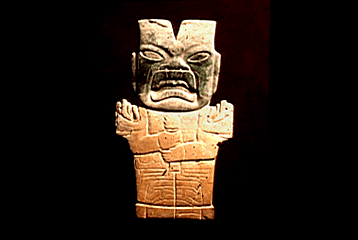| home | Sixth Round Table: Olmec Influence |

|
However, with the advent of new and intensive archaeological and iconographic research methods and the shrinking of the temporal distance between the Olmec and Maya it has become obvious that strong iconographic analogies do exist between the two cultures and that these analogies reflect the survival of certain Olmec beliefs and their incorporation into the political and religious systems of the later Maya.
To isolate Olmec holdovers within the complex iconography of the Maya, it is important first to determine exactly what we mean by "Olmec". For the purpose of this paper, Olmec refers not only to the first inter-Mesoamerican art style, but also the belief system that is reflected in the iconography associated with that style. Between 1200 B.C. and 500 B.C. portable objects rendered in the Olmec style and bearing a complex iconography spread throughout Mesoamerica (Coe 1965b). The actual mechanism by which these objects spread is not known, but current anthropological theory favors some form of trade network. Within such a network works of art, enhanced with symbols derived from the natural environment (Reilly 1987), functioned as valuables exchanged for services and commodities (Flannery 1968:105-108). Such art objects, with their accompanying iconography, could be displayed and manipulated for political purposes by emerging power elites outside the Olmec "heartland" in imitation of Olmec rulers who used the iconography as a pictorial "royal" charter. This charter functioned as a public justification for the hereditary and perhaps divine status with which Olmec rulers were vested in their "heartland" qualities. |
|
Photo: Werner Forman/Art Resource, NY. |
| home | Sixth Round Table: Olmec Influence |